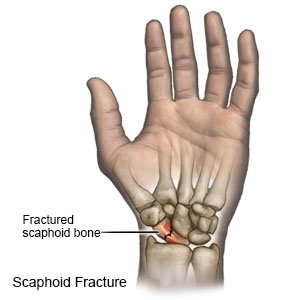Scaphoid Fracture
Medically reviewed by Drugs.com. Last updated on Apr 6, 2025.
AMBULATORY CARE:
A scaphoid fracture
is a break in one of the small bones of your wrist.
 |
Common signs and symptoms:
- Pain and tenderness
- Trouble moving your wrist or thumb
- Swelling where your wrist meets your thumb
Seek care immediately if:
- Your fingers or thumb tingle or are numb or cold, or turn blue or white.
- You have severe pain in your hand or wrist, or your pain worsens.
Call your doctor or orthopedist if:
- You have questions or concerns about your condition or care.
Treatment
may include any of the following:
- A splint or cast may be put on your wrist and hand to decrease movement. These hold the broken bones in place, decrease pain, and prevent more damage to your wrist.
- NSAIDs , such as ibuprofen, help decrease swelling, pain, and fever. This medicine is available with or without a doctor's order. NSAIDs can cause stomach bleeding or kidney problems in certain people. If you take blood thinner medicine, always ask if NSAIDs are safe for you. Always read the medicine label and follow directions. Do not give these medicines to children younger than 6 months without direction from a healthcare provider.
- Prescription pain medicine may be given. Ask your healthcare provider how to take this medicine safely. Some prescription pain medicines contain acetaminophen. Do not take other medicines that contain acetaminophen without talking to your healthcare provider. Too much acetaminophen may cause liver damage. Prescription pain medicine may cause constipation. Ask your healthcare provider how to prevent or treat constipation.
- Surgery may be needed if the broken bone is out of place, or if it does not heal properly.
Manage a scaphoid fracture and help your wrist heal:
- Apply ice on your wrist for 15 to 20 minutes every hour, or as directed. Use an ice pack, or put crushed ice in a plastic bag. Cover it with a towel before you apply it. Ice helps prevent tissue damage, and decreases pain and swelling.
- Elevate your wrist above the level of your heart as often as you can. This will help decrease pain and swelling. Prop your wrist on pillows or blankets to keep it elevated comfortably.
- Do not smoke. Nicotine and other chemicals in cigarettes and cigars can cause lung damage and slow healing. Ask your healthcare provider for information if you currently smoke and need help to quit. E-cigarettes or smokeless tobacco still contain nicotine. Talk to your healthcare provider before you use these products.
- Go to physical or occupational therapy as directed. A physical or occupational therapist can teach you exercises to help improve movement and strength, and to decrease pain.
Follow up with your doctor or orthopedist as directed:
You will need to return for more x-rays to check how your wrist is healing. Write down your questions so you remember to ask them during your visits.
© Copyright Merative 2025 Information is for End User's use only and may not be sold, redistributed or otherwise used for commercial purposes.
The above information is an educational aid only. It is not intended as medical advice for individual conditions or treatments. Talk to your doctor, nurse or pharmacist before following any medical regimen to see if it is safe and effective for you.
Learn more about Scaphoid Fracture
Care guides
Further information
Always consult your healthcare provider to ensure the information displayed on this page applies to your personal circumstances.
